
The Melanoplinae are a subfamily of grasshoppers in the family Acrididae. They are distributed across the Holarctic and Neotropical realms. They are one of the two largest subfamilies in the Acrididae. As of 2001 the Melanoplinae contained over 800 species in over 100 genera, with more species being described continuously.

Tetrigidae is an ancient family in the order Orthoptera, which also includes similar families such as crickets, grasshoppers, and their allies. Species within the Tetrigidae are variously called groundhoppers, pygmy grasshoppers, pygmy devils or "grouse locusts".

Tettigidea is a genus of groundhoppers or pygmy grasshoppers in the tribe Batrachideini from the Americas. There are at least 40 described species in Tettigidea.
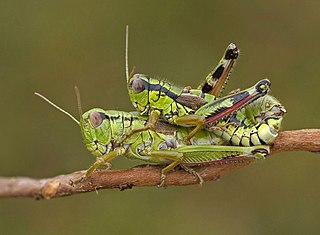
Acridoidea is the largest superfamily of grasshoppers in the order Orthoptera with over 11,000 species found on every continent except Antarctica.

The Tanaoceridae are an insect family in the monotypic superfamily Tanaoceroidea in the suborder Caelifera. They are sometimes called desert long-horned grasshoppers.
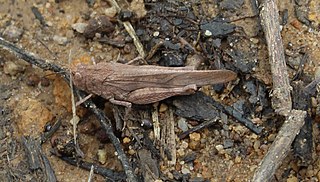
The Ommexechidae are a family of grasshoppers, in the Orthoptera: suborder Caelifera. Species in this family can be found in the Americas.

Romaleinae is a subfamily of lubber grasshoppers in the family Romaleidae, found in North and South America. More than 60 genera and 260 described species are placed in the Romaleinae.

Rhammatocerus is a genus of grasshoppers in the subfamily Gomphocerinae and the tribe Scyllinini. There are about 16 described species in Rhammatocerus, including R. schistocercoides, the "Mato Grosso locust".

Orphulella is a genus of slant-faced grasshoppers in the family Acrididae. There are more than 20 described species in Orphulella, all found in the Americas.
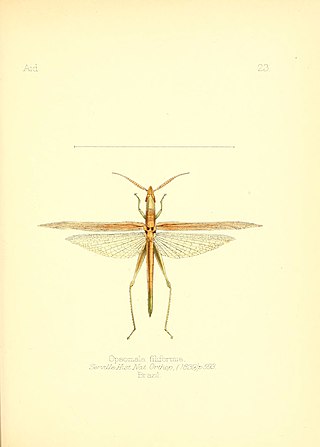
Leptysminae is a subfamily of spur-throat toothpick grasshoppers in the family Acrididae. There are at least 20 genera in Leptysminae, found in North, Central, and South America.

Amblytropidia is a genus of slant-faced grasshoppers in the family Acrididae. There are about 14 described species in Amblytropidia.

Episactidae is a family of grasshoppers in the order Orthoptera. There are about 19 genera and more than 60 described species in Episactidae, found in Central and South America, China, and Madagascar.
Pterophyllini is a tribe of true katydids in the family Tettigoniidae. There are about 16 genera and more than 40 described species in Pterophyllini.
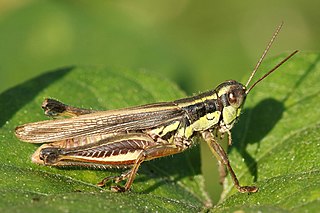
Dichroplus is a genus of spur-throated grasshoppers in the family Acrididae. There are more than 20 described species in Dichroplus, found in North, Central, and South America.

Ronderosia is a genus of spur-throated grasshoppers in the family Acrididae. There are about 10 described species in Ronderosia, found in South America.

Stenopola is a genus of spur-throat toothpick grasshoppers in the family Acrididae. There are about 13 described species in Stenopola, found in the Americas.

Leptysmini is a tribe of spur-throat toothpick grasshoppers in the family Acrididae. There are about 9 genera and more than 30 described species in Leptysmini, found in North, Central, and South America.

Baeacris is a genus of spur-throated grasshoppers in the family Acrididae. There are about nine described species in Baeacris, found in Central and South America.

The Ommatolampidinae are a subfamily of grasshoppers in the family Acrididae, found in central and South America, and based on the type genus Ommatolampis. Derived from the "Ommatolampides" used by Brunner von Wattenwyl in 1893, the first use of the name in its current form was by Rodríguez et al. in 2013; this taxon appears to be paraphyletic.
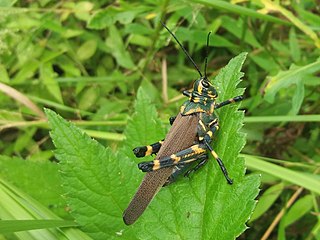
Chromacris speciosa is a grasshopper in the family, Romaleidae, first described in 1824 by Carl Peter Thunberg. It is found in South America and Central America.


















